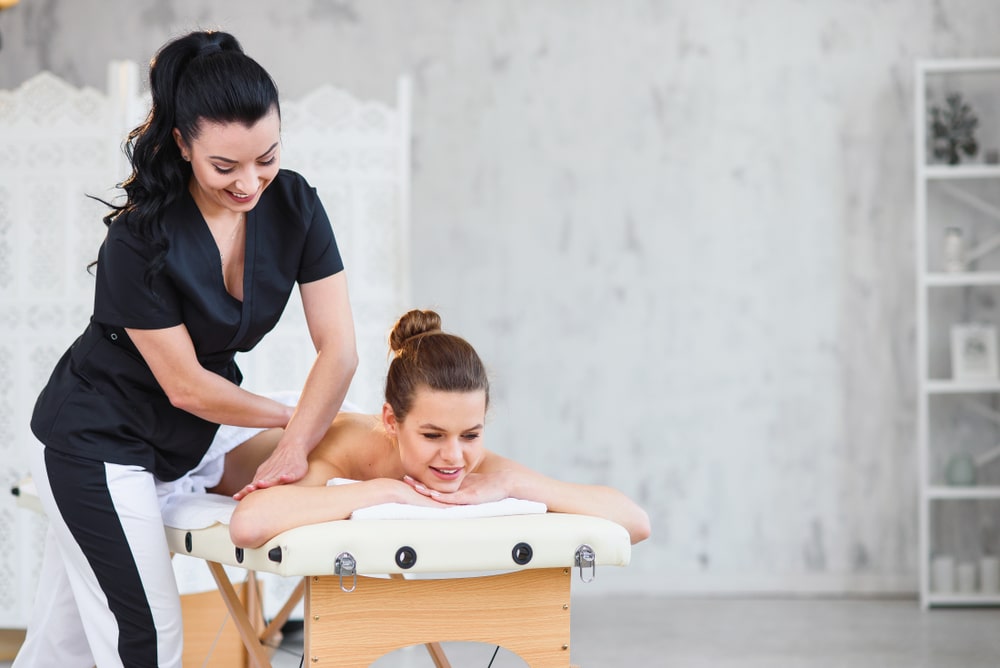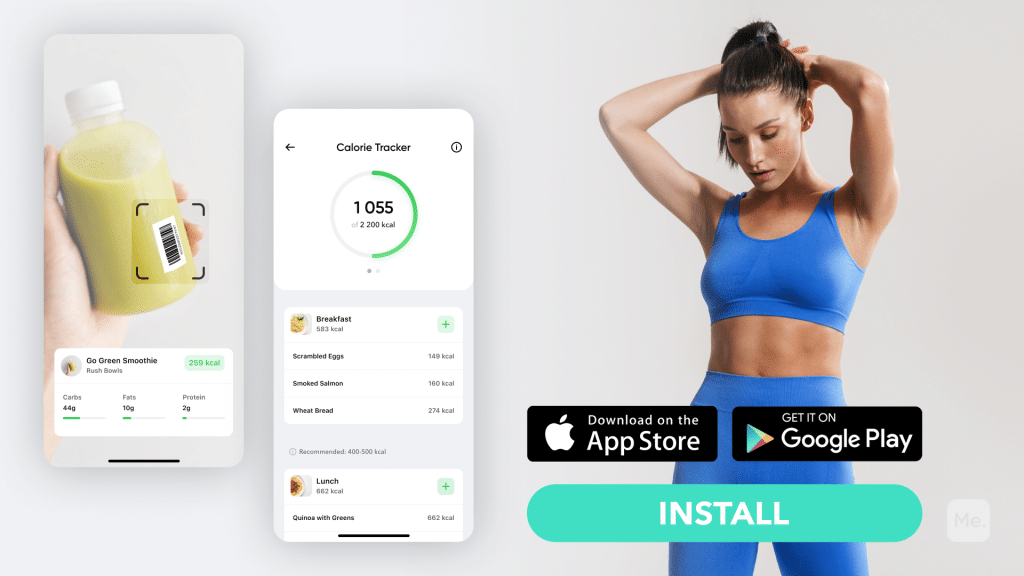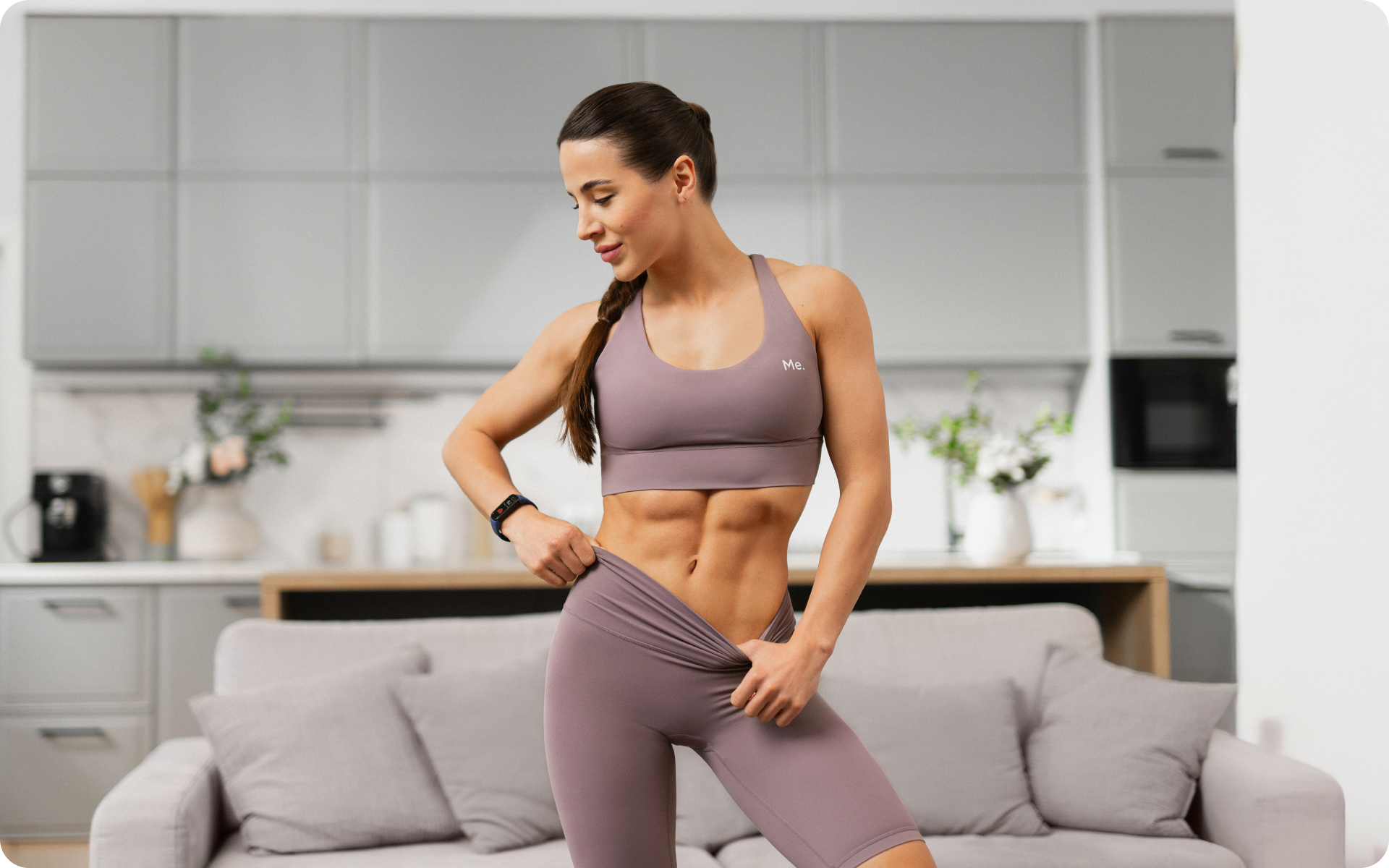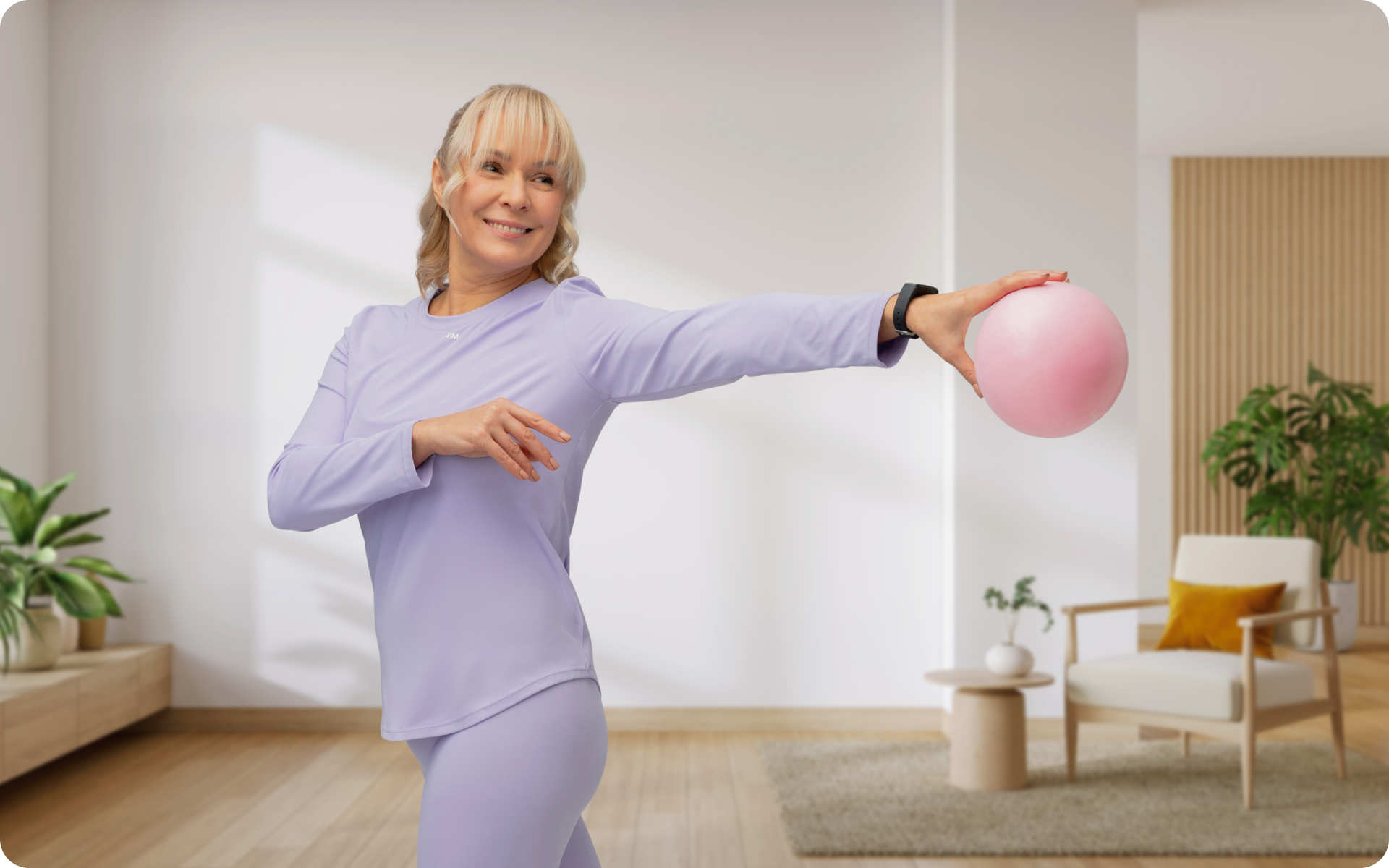We’ve all felt it before– the achy, tired muscles that come from a hard workout. Massages are a great way to help alleviate some of that pain and tension. But should you get a massage before or after your workout?
There isn’t really a right answer to this question. It all depends on what works best for you.
Some people find that they feel more energized after a massage, which is perfect for working out. Others find that the massage relaxes them so much that they’re not able to work out as intensely as they would have liked. If you’re not sure whether you should get a massage before or after your workout, read on as we explore what science has to say about this topic.
Get your personalized
meal plan!
Reasons To Get A Massage Before Exercise
There are several reasons why a pre-workout massage is a good idea.
Endorphin Production
Endorphins are hormones that are released by the body in response to pain or stress. They are responsible for the “runner’s high” that people often experience after a long run. Endorphins have many benefits, including reducing stress, relieving pain, and improving mood (10).
Pre-workout massage can stimulate endorphin production by releasing tension in the muscles. This can help reduce stress and anxiety and make it easier to focus on your workout (10).
Massage also increases blood flow and circulation, which can help improve energy levels and performance (7).
Warm Up Your Muscles
A pre-workout massage is a great way to help warm up your muscles and get them ready for your workout.
By massaging the muscles before you exercise, you can help improve blood circulation and increase the range of motion in your joints (7). This can help reduce the risk of injury and make your workout more effective.
Increase Flexibility And Mobility
Flexibility and mobility are two very important aspects of any workout routine. Flexibility refers to the range of motion that a particular joint can achieve, while mobility is the ability to move freely and easily within that range.
Both flexibility and mobility are essential in performing exercises properly and safely. Improving your flexibility and mobility can help you reach new levels in your workouts, as well as prevent injuries.
One way to improve your flexibility and mobility is through massage. Massage has long been known to help improve flexibility and mobility, as it helps loosen up tight muscles and joints (6).
Pre-workout massage is especially beneficial, since it can help warm up the muscles and get them ready for action. A good pre-workout massage can also help to prevent injuries.
What’s A Good Pre-Workout Massage?
A good pre-workout massage is gentle, yet firm. It should focus on stimulating endorphin production and relieving tension before you push yourself in your workout.
The massage should last for about 10 to 15 minutes and should focus on the neck, shoulders, back, and legs. It’s a good idea to use some light pressure when massaging these areas, as they are often tight and tense.
Avoid deep-tissue work or any massage that is focused on the muscles directly below the skin. These types of massages can be too intense and cause discomfort before your workout.
A lengthy massage is also a bad idea, as it can exhaust your muscles and leave you too sore to work out.
Read More: Aerial Yoga Benefits: 10 Ways This Practice Will Elevate Your Workouts
Reasons To Get A Massage After Exercise
There are also several reasons why getting a massage after exercise is a good idea, such as:
Enhance Recovery
Massage is a great way to help your body recover after a tough workout. Massage helps improve circulation and speed up the healing process. It can also help relieve pain and stiffness, and reduce inflammation (7).
Post-workout massage can help you feel better faster, which can lead to better performance in your next workout.
Reduce Muscle Soreness
Muscle soreness is a common side effect of working out. It can be quite uncomfortable and can take several days to go away.
Massage is a great way to help reduce muscle soreness. Massage helps increase blood flow and circulation, which can help reduce inflammation and hasten the healing process. It can also help relieve pain and stiffness (7).
A post-workout massage can help you feel better faster, leading to better performance in your next workout.
Improved Range Of Motion
Range of motion is the ability to move freely and easily within a particular joint’s range. Improving your range of motion is important for being able to perform exercises properly and safely.
One way to improve your range of motion is through massage. Massage helps loosen up tight muscles and joints, helping you move more freely and easily (4). This will allow you to reach new levels in your workouts, as well as prevent injuries.
What’s A Good Post-Workout Massage?
The best type of post-workout massages is deep tissue or sports massages.
A deep tissue massage is a type of massage that focuses on the deep layers of muscle and connective tissue. It is used to relieve pain and tension in the muscles.
A sports massage is a type of massage that is specifically tailored for athletes. It helps speed up the healing process, reduce inflammation, and prevent injuries (1).
Both of these types of massages are beneficial for improving the range of motion.
The massage should last for about 30 minutes and should take place no more than two hours after a workout. This timing is best to reduce DOMS (delayed onset muscle soreness). DOMS occurs 12 to 24 hours after a strenuous workout and is the result of micro-tears in the muscle (2).
The massage should focus on the neck, shoulders, back, and legs. Use light to moderate pressure when massaging these areas.
Why Does Your Body Hurt After A Workout?
When you work out, lactic acid and other metabolites build up in your muscles. This can cause pain and soreness in the hours and days after your workout (12).
Furthermore, building muscle requires tearing down muscle fibers. This process causes small injuries to the muscles, which can lead to inflammation and pain (12).
Aside from getting a post-workout massage, there are a few things you can do to reduce post-workout pain:
Hydrate Well Before, During, And After Your Workout
One of the best ways to reduce muscle soreness after a workout is to drink plenty of fluids. When you’re dehydrated, your muscles can become tired and sore more easily. By drinking plenty of water or other hydrating fluids, you can help keep your muscles healthy and energized (5).
In addition to helping reduce muscle soreness, hydrating can also help improve your overall performance during a workout (5).
When you’re well-hydrated, your muscles will have more energy, and you’ll less likely feel fatigued. This can help you push yourself harder during your workouts and ultimately get better results.
Warm-Up Properly Before The Workout
It is now understood that warming up before a workout reduces DOMS. The reason for this appears to be that the warm-up induces a series of beneficial changes in the muscle tissues (11).
These changes include an increase in blood flow and delivery of oxygen and nutrients to the muscles, an increase in the removal of waste products, as well as a decrease in muscle stiffness. All of these changes are beneficial in terms of reducing the risk of DOMS and optimizing performance during the workout (11).
In addition, a warm-up may also help activate the muscles and get them ready for work. This is particularly important for beginners, who may not be used to working out their muscles and can therefore be more susceptible to DOMS (11).
A good warm-up will increase the blood flow to these muscles, get them ready for activity, and help reduce the risk of injury (11).
Yanking yourself back in shape has never been so easy with our game-changing fitness app! Start transforming your life with BetterMe!
Stretching Before And After Your Workout
One of the most common ways to prevent muscle soreness is through stretching. Stretching helps warm up the muscles and increase blood flow to the area. This can help to reduce the risk of developing sore muscles after a workout (8).
Additionally, stretching can also help to loosen tight muscles and improve flexibility. This can help you move more easily and reduce the risk of developing muscle soreness (8).
There are two types of stretches– static and dynamic. Static stretches are held for a certain length of time. On the other hand, dynamic stretches are performed rhythmically. Both types of stretches can be beneficial in preventing muscle soreness (8).
Static stretches are best done after a workout, while dynamic stretches can be performed before a workout.
Examples of static stretches are:
-
Hamstring Stretch
- Lie on your back with one leg bent and the other leg straight.
- Place a strap, towel, or band around the ball of your foot and gently pull the leg towards your head until you feel a stretch in the hamstring.
- Hold for 20 seconds, then release.
-
Quadriceps Stretch
- Stand up tall and grab onto a sturdy object with one hand.
- Bend your knee and pull your heel towards your butt. You should feel a stretch in the front of your thigh.
- Hold for 20 seconds, then release.
-
Chest Stretch
- Stand up tall and clasp your hands together behind your back.
- Push your chest out and hold for 20 seconds.
Examples of dynamic stretches are:
-
Arm Circles
- Stand with your arms by your sides and slowly rotate your arms in a circular motion.
-
Lunges
- Step forward with one foot and lower your body until your front thigh is parallel to the ground.
- Keep your back straight and push yourself back to the starting position.
- Repeat on the other side.
-
High Knees
- Stand with your feet hip-width apart and lift your knees as high as you can.
- Pump your arms as you do this for extra intensity.
Stretching is a great way to prevent muscle soreness, but it’s important to make sure that you are doing the stretches correctly. If you are not sure how to do a particular stretch, be sure to ask a fitness professional for help.
Read More: CrossFit Workout: The Ultimate Guide For Beginners
Choose The Right Post Workout Snack
After an intense workout, you may be feeling the effects of DOMS (delayed onset muscle soreness). This is caused by microscopic tears in your muscles that occur during exercise.
While there is no cure for DOMS, consuming a post-workout snack can help to reduce the severity of the symptoms (3).
The best post-workout snacks are those that are high in protein and carbohydrates. Protein helps to rebuild muscle tissue, while carbohydrates provide energy for your body to use. Some good examples of post-workout snacks include:
- Protein shake or smoothie
- Piece of fruit with a handful of nuts or seeds
- Small bowl of oatmeal with a scoop of protein powder
- Turkey or ham sandwich on whole-wheat bread
If you are looking for something portable that you can take with you on the go, try packing a few of these snacks in a small cooler. This will help to make sure that you have something to eat after your workout, no matter where you are.
Get Enough Sleep
Getting enough sleep is crucial for reducing muscle soreness after a workout (3). When you’re well-rested, your body has time to rebuild the muscles you worked hard in the gym. This means that you’ll experience less muscle soreness and be able to get back to your workouts sooner.
BetterMe is your fast-track ticket to a long-lasting weight loss! Tailor your fitness journey and maximize your results with just a couple of swipes!
The Bottom Line
Should you get a massage before or after a workout? It depends. Pre-workout massages can help loosen up your muscles and increase blood flow, while post-workout massages can help to reduce muscle soreness.
However, if you are not sure how to do a particular massage, be sure to consult a professional.
DISCLAIMER:
This article is intended for general informational purposes only and does not serve to address individual circumstances. It is not a substitute for professional advice or help and should not be relied on for making any kind of decision-making. Any action taken as a direct or indirect result of the information in this article is entirely at your own risk and is your sole responsibility.
BetterMe, its content staff, and its medical advisors accept no responsibility for inaccuracies, errors, misstatements, inconsistencies, or omissions and specifically disclaim any liability, loss or risk, personal, professional or otherwise, which may be incurred as a consequence, directly or indirectly, of the use and/or application of any content.
You should always seek the advice of your physician or other qualified health provider with any questions you may have regarding a medical condition or your specific situation. Never disregard professional medical advice or delay seeking it because of BetterMe content. If you suspect or think you may have a medical emergency, call your doctor.
SOURCES:
- Correction: Effect of sports massage on performance and recovery: a systematic review and meta-analysis (2019, bmj.com)
- Delayed onset muscle soreness: treatment strategies and performance factors (2003, pubmed.gov)
- Does Sleep Affect Delayed Onset Muscle Soreness (DOMS) In Olympic Hockey Players (2015, und.edu)
- Effectiveness of massage therapy on the range of motion of the shoulder: a systematic review and meta-analysis (2017, nih.gov)
- Fluid consumption, exercise, and cognitive performance (2016, nih.gov)
- Increased Flexibility – Benefits of Massage (n.d., physio.co.uk)
- Massage therapy improves circulation, alleviates muscle soreness (2014, sciencedaily.com)
- Nutritional and Supplementation Strategies to Prevent and Attenuate Exercise-Induced Muscle Damage: a Brief Review (2019, nih.gov)
- Stretching to prevent or reduce muscle soreness after exercise (2011, pubmed.gov)
- The Truth Behind ‘Runner’s High’ and Other Mental Benefits of Running (n.d., hopkinsmedicine.org)
- Warm-up reduces delayed onset muscle soreness but cool-down does not: a randomised controlled trial (2007, pubmed.gov)
- Why do I feel pain after exercise? (2021, nhs.uk)













